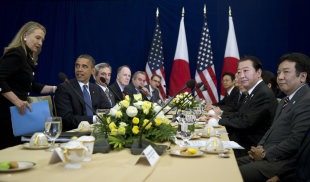The rockets and missiles fell silent over Gaza for the first time in eight days today, but gunfire erupted in the crowded streets of the Palestinian enclave to celebrate the announcement of a ceasefire in the bloody conflict between Israel and Hamas.
The two sides fired final salvos at one another up until the final moments before the 2 p.m. ET cease-fire deadline. At least one Israeli missile landed at 1:57 p.m. ET in Gaza, and four rockets were launched toward the Israeli province of Beer Sheva at 1:59 p.m. ET.
After 2 p.m. ET, however, the sky was finally empty of munitions.
The eight days of fighting left 130 Palestinans and five Israelis dead, and badly damaged many of Gaza's buildings. A bomb that exploded on a bus in Tel Aviv earlier today left an additional 10 Israelis wounded.
The fighting came to an end after a meeting between Egyptian President Mohammed Morsi and U.S. Secretary of State Hillary Clinton.
"This is a critical moment for the region," Clinton said after the meeting, standing next to Egyptian Foreign Minister Mohamed Kamel Amr to announce the deal.
"The people of this region deserve a chance to live free of fear and violence and today's agreement is a step" in that direction, Clinton said. "Now we have to focus on reaching a durable outcome."
Clinton said that Egypt and the U.S. would help support the peace process going forward.
"Ultimately every step must move us toward a comprehensive peace for people of the region," she said.
Israeli Prime Minister Benjamin Netanyahu confirmed the cease-fire from Tel Aviv after Clinton's announcement.
"I agree that that it was a good idea to give an opportunity to the cease-fire... in order to enable Israeli citizens to return to their day to day lives," Netanyahu said.
He reiterated that it was vital to Israel's security to "prevent smuggling of arms to terrorist organizations" in the future.
An Israeli official told ABC News that the ceasefire would mean a "quiet for quiet" deal, in which both sides stop shooting and "wait and see what happens."
"Who knows if the ceasefire will even last two minutes," the official said. The official said that any possible agreement on borders and blockades on the Gaza/Israel border would come only after a period of quiet.
Clinton and Morsi met for three hours in Cairo today to discuss an end to the violence. The secretary of state met with Netanyahu Tuesday night for more than two hours, saying she sought to "de-escalate the situation in Gaza."
The fighting dragged on Tuesday night and Wednesday morning despite Hamas officials declaring publicly Tuesday afternoon that they expected a cease-fire would be announced Tuesday night, after Clinton and Netanyahu's talks.
The airstrikes by the Israeli Defense Forces overnight hit government ministries, underground tunnels, a banker's empty villa and a Hamas-linked media office. At least four strikes within seconds of each other pulverized a complex of government ministries the size of a city block, rattling nearby buildings and shattering windows.
Hours later, clouds of acrid dust still hung over the area and smoke still rose from the rubble. Gaza health officials said there were no deaths or injuries.
On Wednesday morning, the IDF said they had destroyed 50 underground rocket launching sites in Gaza. They also said that Israel's "Iron Dome" missile shield intercepted two rockets from Gaza into Israel overnight as well.
Around 12 p.m. in Israel, however, a bomb exploded on a public bus near the nation's military headquarters in Tel Aviv, in one of the city's busiest areas. Israel police said the explosion was a terrorist attack, the first in Israel since 2006.
Upon landing in Cairo to meet with Morsi, Clinton released a statement condemning the attack.
"The United States strongly condemns this terrorist attack and our thoughts and prayers are with the victims and the people of Israel. As I arrive in Cairo, I am closely monitoring reports from Tel Aviv, and we will stay in close contact with Prime Minister Netanyahu's team. The United States stands ready to provide any assistance that Israel requires," she said.
Also Read











